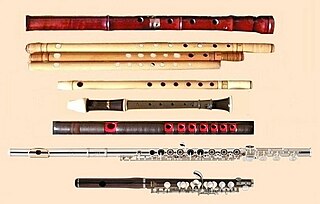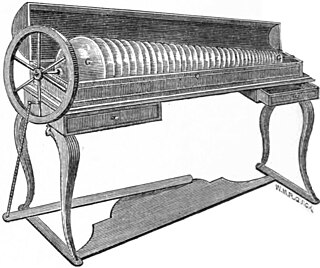The clarinet is a single-reed musical instrument in the woodwind family, with a nearly cylindrical bore and a flared bell.

The flute is a member of a family of musical instruments in the woodwind group. Like all woodwinds, flutes are aerophones, producing sound with a vibrating column of air. Unlike woodwind instruments with reeds, a flute produces sound when the player's air flows across an opening. In the Hornbostel–Sachs classification system, flutes are edge-blown aerophones. A musician who plays the flute is called a flautist or flutist.
In music, a bow is a tensioned stick which has hair coated in rosin affixed to it. It is moved across some part of a musical instrument to cause vibration, which the instrument emits as sound. The vast majority of bows are used with string instruments, such as the violin, viola, cello, and bass, although some bows are used with musical saws and other bowed idiophones.

Concert pitch is the pitch reference to which a group of musical instruments are tuned for a performance. Concert pitch may vary from ensemble to ensemble, and has varied widely over time. The ISO defines international standard pitch as A440, setting 440 Hz as the frequency of the A above middle C. Frequencies of other notes are defined relative to this pitch.

The glass harmonica, also known as the glass armonica, glass harmonium, bowl organ, hydrocrystalophone, or simply the armonica or harmonica, is a type of musical instrument that uses a series of glass bowls or goblets graduated in size to produce musical tones by means of friction. It was invented in 1761 by Benjamin Franklin.

A fife is a small, high-pitched, transverse aerophone, that is similar to the piccolo. The fife originated in medieval Europe and is often used in fife and drum corps, military units, and marching bands. Someone who plays the fife is called a fifer. The word fife comes from the German Pfeife, meaning pipe, which comes from the Latin word pipare.

Rodgers Instruments Corporation is an American manufacturer of classical and church organs. Rodgers was incorporated May 1, 1958 in Beaverton, Oregon by founders, Rodgers W. Jenkins and Fred Tinker, employees of Tektronix, Inc., of Portland, Oregon, and members of a Tektronix team developing transistor-based oscillator circuits. Rodgers was the second manufacturer of solid state oscillator-based organs, completing their first instrument in 1958. Other Rodgers innovations in the electronic organ industry include solid-state organ amplifiers (1962), single-contact diode keying (1961), reed switch pedal keying for pedalboards (1961), programmable computer memory pistons (1966), and the first MIDI-supported church organs (1986).

Anthony Terrell Smith, better known by his stage name Tone Lōc, is an American rapper. He is known for his raspy voice, his hit songs "Wild Thing" and "Funky Cold Medina", for which he was nominated for a Grammy Award, and for being featured in "We're All in the Same Gang", a collaborative single by the West Coast Rap All-Stars.
The bass flute is a member of the flute family. It is in the key of C, pitched one octave below the concert flute. Despite its name, its playing range makes it the tenor member of the flute family. Because of the length of its tube, it is usually made with a J-shaped head joint, which brings the embouchure hole within reach of the player. Its soft dynamic range means in large ensembles it is easily obscured unless amplified or lightly scored; however its unique timbre in the low register can be very effective, especially in solo works, small ensembles, and flute choirs. The "bass flute in F" produced by Kotato & Fukushima is a contra-alto flute.
The Western concert flute is a family of transverse (side-blown) woodwind instruments made of metal or wood. It is the most common variant of the flute. A musician who plays the flute is called a “flautist” in British English, a “flutist” in American English.

The flageolet is a woodwind instrument and a member of the family of duct flutes that includes recorders and tin whistles. Its invention was erroneously ascribed to the 16th-century Sieur Juvigny in 1581. There are two basic forms of the instrument: the French, having four finger holes on the front and two thumb holes on the back; and the English, having six finger holes on the front and sometimes a single thumb hole on the back. The latter was developed by English instrument maker William Bainbridge, resulting in the "improved English flageolet" in 1803. There are also double and triple flageolets, having two or three bodies that allowed for a drone and countermelody. Flageolets were made until the 19th century.

A pipe is a tubular wind instrument in general, or various specific wind instruments. The word is an onomatopoeia, and comes from the tone which can resemble that of a bird chirping.

The Irish flute is a conical-bore, simple-system wooden flute of the type favoured by classical flautists of the early 19th century, or to a flute of modern manufacture derived from this design. The majority of traditional Irish flute players use a wooden, simple-system flute.

A glass harp is a musical instrument made of upright wine glasses.

Dennis James is an American musician and historic preservationist. Beginning in 1969, he presented historically informed live accompaniments for silent films, with piano, theatre organ, chamber ensemble and full symphony orchestras, throughout the United States, Canada, Mexico and overseas. He is now primarily active as a noted multi-instrumentalist, specializing on Franklin glass armonica and the theremin, prominently performing in New York at the Metropolitan Opera, for Hollywood film scorings, and repeat performances at Lincoln Center's Mostly Mozart Festival plus performing at the Tanglewood Festival with the Boston Symphony Orchestra performing the intricate glass armonica complete part in the U.S. debut of George Benjamin's opera "Written on Skin".

A nose whistle is a wind instrument played with the nose and mouth cavity. Often made of wood, they are also constructed with plastic, clay, or sheet metal.

Claude-Paul Taffanel was a French flautist, conductor and instructor, regarded as the founder of the French Flute School that dominated much of flute composition and performance during the mid-20th century.

A wind instrument is a musical instrument that contains some type of resonator in which a column of air is set into vibration by the player blowing into a mouthpiece set at or near the end of the resonator. The pitch of the vibration is determined by the length of the tube and by manual modifications of the effective length of the vibrating column of air. In the case of some wind instruments, sound is produced by blowing through a reed; others require buzzing into a metal mouthpiece, while yet others require the player to blow into a hole at an edge, which splits the air column and creates the sound.
This family of musical instruments includes those whose primary material is glass. They may be played using percussive techniques, such as striking the glass to produce a sound, or by utilizing friction to generate a resonant sound. Many glass instruments produce an ethereal, otherworldly timbre. A well-known glass instrument is Ben Franklin's glass harmonica.

The William S. Haynes Flute Company is an American flute-manufacturing company, established in 1888 by William S. Haynes and George W. Haynes. Originating in Boston, the company has since relocated its main workshop to Acton, Massachusetts.















